California Condor
| California Condor Temporal range: Early Pleistocene to Recent | |
|---|---|
 | |
| At San Diego Zoo, USA | |
| Conservation status | |
| Scientific classification | |
| Kingdom: | Animalia |
| Phylum: | Chordata |
| Class: | Aves |
| Order: | Incertae sedis (disputed) |
| Family: | Cathartidae |
| Genus: | Gymnogyps Lesson, 1842 |
| Species: | G. californianus |
| Binomial name | |
| Gymnogyps californianus (Shaw, 1797) | |
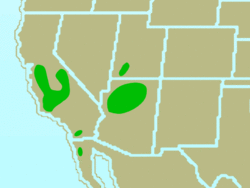 | |
| Synonyms | |
|
Genus-level:
Species-level:
| |
The California Condor (Gymnogyps californianus) is a New World vulture, the largest North American land bird. This condor became extinct in the wild in 1987 (all remaining wild individuals were captured) but has been reintroduced to northern Arizona and southern Utah (including the Grand Canyon area and Zion National Park), coastal mountains of central and southern California, and northern Baja California. Although other fossil members are known, it is the only surviving member of the genus Gymnogyps.
The plumage is black with patches of white on the underside of the wings and the head is largely bald, with skin color ranging from gray on young birds to yellow and bright orange on breeding adults. Its huge 3.0 m (9.8 ft) wingspan is the largest of any North American bird, and its weight of up to 12 kg (26 lb) makes it nearly equal the Trumpeter Swan, the largest among native North American bird species. The condor is a scavenger and eats large amounts of carrion. It is one of the world's longest-living birds, with a lifespan of up to 60 years.[2]
Condor numbers dramatically declined in the 20th century due to poaching, lead poisoning, and habitat destruction.[3] A conservation plan was put in place by the United States government that led to the capture of all 22 remaining wild condors in 1987. These surviving birds were bred at the San Diego Zoo Safari Park and the Los Angeles Zoo. Numbers rose through captive breeding and, beginning in 1991, condors have been reintroduced into the wild. The California Condor is one of the world's rarest bird species: as of May 2013, population counts put the number of known condors at 435, including 237 living in the wild and 198 in captivity.[4] The condor is a significant bird to many Californian Native American groups and plays an important role in several of their traditional myths.
Taxonomy

The California Condor was described by English naturalist George Shaw in 1797 as Vultur californianus. It was originally classified in the same genus as the Andean Condor (V. gryphus), but, due to the Andean Condor's slightly different markings, slightly longer wings, and tendency to kill small animals to eat,[5] the California Condor has now been placed in its own monotypic genus. The generic name Gymnogyps is derived from the Greek gymnos/γυμνος "naked" or "bare", and gyps/γυψ "vulture",[6] while the specific name californianus comes from its location in California. The word condor itself is derived from the Ecuadorian Quechua cuntur.[7]
The exact taxonomic placement of the California Condor and the other six species of New World vultures remains unclear.[8] Though similar in appearance and ecological roles to Old World vultures, the New World vultures evolved from a different ancestor in a different part of the world. Just how different the two are is currently under debate, with some earlier authorities suggesting that the New World vultures are more closely related to storks.[9] More recent authorities maintain their overall position in the order Falconiformes along with the Old World vultures[10] or place them in their own order, Cathartiformes.[11] The South American Classification Committee has removed the New World vultures from Ciconiiformes and instead placed them in Incertae sedis, but notes that a move to Falconiformes or Cathartiformes is possible.[8]
Evolutionary history
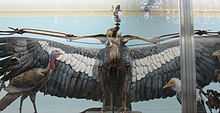
The genus Gymnogyps is an example of a relict distribution. During the Pleistocene epoch, this genus was widespread across the Americas. From fossils, the Floridan Gymnogyps kofordi from the Early Pleistocene and the Peruvian Gymnogyps howardae from the Late Pleistocene have been described.[12] A condor found in Late Pleistocene deposits on Cuba was initially described as Antillovultur varonai, but has since been recognized as another member of Gymnogyps, Gymnogyps varonai. It may even have been a subspecies of the California Condor.[citation needed][12]
Today's California Condor is the sole surviving member of Gymnogyps and has no accepted subspecies; although its range greatly contracted during the Holocene, the species always had a small and inbred population. However, there is a Late Pleistocene form that is sometimes regarded as a palaeosubspecies, Gymnogyps californianus amplus. Current opinions are mixed regarding the classification of the form as a chronospecies or a separate species Gymnogyps amplus.[13] Gymnogyps amplus occurred over much of the bird's historical range – even extending into Florida – but was larger, having about the same weight as the Andean Condor. This bird also had a wider bill.[14]
Description

The adult California Condor is a uniform black with the exception of large triangular patches or bands of white on the underside of the wings. It has gray legs and feet, an ivory-colored bill, a frill of black feathers surrounding the base of the neck, and brownish red eyes.[15] The juvenile is mostly a mottled dark brown with blackish coloration on the head. It has mottled gray instead of white on the underside of its flight feathers.[16]
As an adaptation for hygiene, the condor's head and neck have few feathers, which exposes the skin to the sterilizing effects of dehydration and solar ultraviolet light at high altitudes.[citation needed] The skin of the head and neck is capable of flushing noticeably in response to emotional state, a capability that can serve as communication between individuals.[17] The skin color varies from yellowish to a glowing reddish-orange.[15] The birds do not have true syringeal vocalizations. They can make a few hissing or grunting sounds only heard when very close.[18]
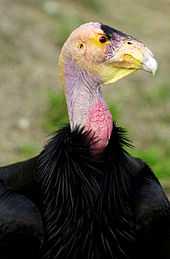
Contrary to the usual rule among true birds of prey, the female is slightly smaller than the male. Overall length can range from 109 to 140 cm (43 to 55 in) and wingspan from 2.49 to 3 m (8.2 to 9.8 ft). Their weight can range from 7 to 14.1 kg (15 to 31 lb), with estimations of average weight ranging from 8 to 9 kg (18 to 20 lb).[16][19] Wingspans of up to 3.4 m (11 ft) have been reported but no wingspan over 3.05 m (10.0 ft) has been verified.[20] Most measurements are from birds raised in captivity, so determining if there are any major differences in measurements between wild and captive condors is difficult.
California Condors have the largest wingspan of any North American bird. They are surpassed in both body length and weight only by the Trumpeter Swan and the introduced Mute Swan. The American White Pelican and Whooping Crane also have longer bodies than the condor. Condors are so large that they can be mistaken for a small, distant airplane, which possibly occurs more often than they are mistaken for other species of bird.[21]
The middle toe of the California Condor's foot is greatly elongated, and the hind one is only slightly developed. The talons of all the toes are straight and blunt, and are thus more adapted to walking than gripping. This is more similar to their supposed relatives the storks[22][23] than to birds of prey and Old World vultures, which use their feet as weapons or organs of prehension.
Historic range

At the time of human settlement of the Americas, the California Condor was widespread across North America; condor bones from the late Pleistocene have been found at the Cutler Fossil Site in southern Florida.[24] However, climate changes associated with the end of the last glacial period and the extinction of the Pleistocene megafauna led to a subsequent reduction in range and population. Five hundred years ago, the California Condor roamed across the American Southwest and West Coast. Faunal remains of condors have been found documented in Arizona,[25] Nevada,[26] New Mexico,[27][28] and Texas.[29] The Lewis and Clark Expedition of the early 19th century reported on their sighting and shooting of California Condors near the mouth of the Columbia River.[30][31]
Habitat
The condors live in rocky shrubland, coniferous forests, and oak savannas.[1] They are often found near cliffs or large trees, which they use as nesting sites. Individual birds have a huge range and have been known to travel up to 250 km (150 mi) in search of carrion.
There are two sanctuaries dedicated to this bird, the Sisquoc Condor Sanctuary in the San Rafael Wilderness[32] and the Sespe Condor Sanctuary in the Los Padres National Forest. These areas were chosen because of their prime condor nesting habitat.
Ecology and behavior
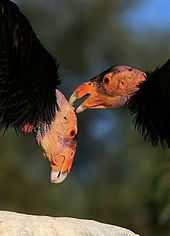
When in flight, the movements of the condor are remarkably graceful. The lack of a large sternum to anchor their correspondingly large flight muscles restricts them to being primarily soarers. The birds flap their wings when taking off from the ground, but after attaining a moderate elevation they largely glide, sometimes going for miles without a single flap of their wings. They have been known to fly up to speeds of 90 km/h (55 mph) and as high as 4,600 m (15,000 ft).[33] They prefer to roost on high perches from which they can launch without any major wing-flapping effort. Often, these birds are seen soaring near rock cliffs, using thermals to aid them in keeping aloft.[34]
The California Condor has a long life span, reaching up to 60 years.[2][3] If it survives to adulthood, the condor has few natural threats other than humans.[35] Their vocal display is limited to grunts and hisses.[17] Condors bathe frequently and can spend hours a day preening their feathers.[33] Condors also perform urohidrosis, or defecate on their legs, to reduce their body temperature.[17] There is a well-developed social structure within large groups of condors, with competition to determine a pecking order decided by body language, competitive play behavior, and a variety of hisses and grunts. This social hierarchy is displayed especially when the birds feed, with the dominant birds eating before the younger ones.[36]
Diet
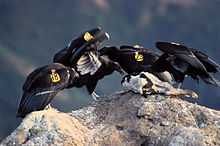
Wild condors inhabit large territories, often traveling 250 km (160 mi) a day in search of carrion.[37] It is thought that in the early days of its existence as a species, the California Condor lived off the carcasses of the "megafauna", which are now extinct in North America. They still prefer to feast on large, terrestrial mammalian carcasses such as deer, goats, sheep, donkeys, horses, pigs, cougars, bears, or cattle. Alternatively, they may feed on the bodies of smaller mammals, such as rabbits or coyotes, aquatic mammals such as whales and California Sea Lions, or salmon. Bird and reptile carcasses are rarely eaten. Since they do not have a sense of smell,[38] they spot these corpses by looking for other scavengers, like eagles and smaller vultures, the latter of which cannot rip through the tougher hides of these larger animals with the efficiency of the larger condor. They can usually intimidate other scavengers away from the carcass, with the exception of bears, which will ignore them, and Golden Eagles, which will fight a condor over a kill or a carcass.[15] In the wild they are intermittent eaters, often going for between a few days to two weeks without eating,[37] then gorging themselves on 1–1.5 kilograms (2.2–3.3 lb) of meat at once.
Reproduction
.jpg)
Condors begin to look for a mate when they reach sexual maturity at the age of six.[33] To attract a prospective mate, the male condor performs a display. In the display, the male turns his head red and puffs out his neck feathers. He then spreads his wings and slowly approaches the female. If the female lowers her head to accept the male, the condors become mates for life.[36] The pair makes a simple nest in caves or on cliff clefts, especially ones with nearby roosting trees and open spaces for landing. A mated female lays one bluish-white egg every other year. Eggs are laid as early as January to as late as April.[39] The egg weighs about 280 g (10 oz) and measures from 90–120 mm (3.5–4.75 in.) in length and about 67 mm (2.6 in.) in width. If the chick or egg is lost or removed, the parents "double clutch", or lay another egg to take the lost one's place. Researchers and breeders take advantage of this behavior to double the reproductive rate by taking the first egg away for puppet-rearing; this induces the parents to lay a second egg, which the condors are sometimes allowed to raise.[40]
The eggs hatch after 53 to 60 days of incubation by both parents. Chicks are born with their eyes open and sometimes can take up to a week to leave the shell completely.[17] The young are covered with a grayish down until they are almost as large as their parents. They are able to fly after five to six months, but continue to roost and forage with their parents until they are in their second year, at which point the parents typically turn their energies to a new nest.[15] Ravens are the main predatory threat to condor eggs, while golden eagles and bears are potential predators of condor offspring.
Conservation

Current status
In modern times, a wide variety of causes have contributed to the condor's decline. Its low clutch size (one young per nest), combined with a late age of sexual maturity, make the bird vulnerable to artificial population decline. Significant damage to the condor population is also attributed to poaching, especially for museum specimens,[41] lead poisoning (from eating animals containing lead shot),[42] DDT poisoning,[43] electric power lines, egg collecting, and habitat destruction. During the California Gold Rush, some condors were even kept as pets.[44] The leading cause of mortality in nestling condors is the ingestion of trash that is fed to them by their parents.[45]
In addition to this, cattle ranchers who observed condors feeding on the dead young of their cattle assumed that the birds killed the cattle. This fallacy led to the condor's extirpation in some parts of the western United States. This belief was so deeply ingrained that the reintroduction of condors to the Grand Canyon was challenged by some cattle ranchers, who mistakenly believed that the bird hunted calves and lambs.[46]
Unanticipated deaths among recent condor populations occurred due to contact with Golden Eagles, lead poisoning, and other factors such as power line collisions. Since 1994, captive-bred California Condors have been trained to avoid power lines and people. Since the implementation of this aversion conditioning program, the number of condor deaths due to power lines has greatly decreased.[47] Lead poisoning due to fragmented lead bullets in large game waste is a particularly big problem for condors due to their extremely strong digestive juices;[48] this lead waste is not as much of a problem for other avian scavengers such as the Turkey Vulture and Common Raven. This problem has been addressed in California by the Ridley-Tree Condor Preservation Act, a bill that went into effect July 1, 2008 that requires that hunters use non-lead bullets when hunting in the condor's range.[49] Blood lead levels in Golden Eagles as well as Turkey Vultures has declined with the implementation of the Ridley-Tree Condor Preservation Act, demonstrating that the legislation has helped reduce other species' lead exposures aside from the California Condor.[50]
California Condor Recovery Plan
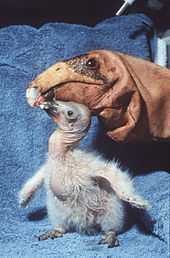
As the condor's population continued to decline, discussion began about starting a captive breeding program for the birds. Opponents to this plan argued that the condors had the right to freedom, that capturing all of the condors would change the species' habits forever, and that the cost was too great.[51] However, the project received the approval of the United States government, and the capture of the remaining wild condors was completed on Easter Sunday 1987, when AC-9, the last wild condor, was captured.[52] There were only 22 condors in existence, all in captivity.
The goal of the California Condor Recovery Plan was to establish two geographically separate populations, one in California and the other in Arizona, each with 150 birds and at least 15 breeding pairs. As the Recovery Program works toward this goal the number of release sites has grown. There are three active release sites in California, one in Arizona and one in Baja California, Mexico.[53]
The captive breeding program, led by the San Diego Wild Animal Park and Los Angeles Zoo, got off to a slow start due to the condor's mating habits. However, utilizing the bird's ability to double clutch, biologists began removing the first egg from the nest and raising it with puppets, allowing the parents to lay another egg.
As the number of condors grew, attention began to focus on releasing some back into the wild. In 1988, the United States Fish and Wildlife Service began a reintroduction experiment involving the release of captive Andean Condors into the wild in California. Only females were released, to eliminate the possibility of accidentally introducing a South American species into the United States. The experiment was a success, and all the Andean Condors were recaptured and re-released in South America.[33] California Condors were released in 1991 and 1992 in California, and again in 1996 in Arizona near the Grand Canyon.[16] Though the birth rate remains low in the wild, their numbers are increasing steadily through regular releases of captive-reared adolescents.

The California Condor conservation project may be one of the most expensive species conservation projects in United States history,[54] costing over $35 million, including $20 million in federal and state funding, since World War II.[55] As of 2007 the annual cost for the condor conservation program was around $2.0 million per year.[55] However, nesting milestones have been recently reached by the reintroduced condors. In 2003, the first nestling fledged in the wild since 1981.[46] In March 2006, a pair of California Condors, released by Ventana Wildlife Society, attempted to nest in a hollow tree near Big Sur, California. This was the first time in more than 100 years in which a pair of California Condors had been seen nesting in Northern California.[56] As of November 2011 there are 394 individuals living, including 205 in the wild[2][3] and the rest in the San Diego Wild Animal Park, the Los Angeles Zoo, the Oregon Zoo, and the World Center for Birds of Prey in Boise, Idaho. As of October 2010, the wild condor population in its name state of California reached 100 individuals, and 73 wild condors in Arizona.[53] As of May 2012, the number of living individuals has reached 405, with 179 living in captivity.[57]
As the Recovery Program achieved milestones, a fifth active release site in Sierra de San Pedro Mártir National Park, Baja California, Mexico, was added to the three release sites in California (Big Sur, Pinnacles National Park and Bitter Creek National Wildlife Refuge) and the Vermilion Cliffs release site in Arizona.[58][59] In early 2007, a California Condor laid an egg in Mexico for the first time since at least the 1930s.[60] The population of the condors has risen due to these wild and also captive nestings. In the spring of 2009, a second wild chick was born in the Sierra de San Pedro Mártir National Park and was named Inyaa ("Sun" in the Kiliwa language) by local environmentalists.[61]
Relationship with humans
Throughout its historic range, the California Condor has been a popular subject of mythology and an important symbol to Native Americans. Unusually,[62] this bird takes on different roles in the storytelling of the different tribes.
The Wiyot tribe of California say that the condor recreated mankind after Above Old Man wiped humanity out with a flood.[63] However, other tribes, such as California's Mono, viewed the condor as a destroyer, not a creator. They say that Condor seized humans, cut off their heads, and drained their blood so that it would flood Ground Squirrel's home. Condor then seized Ground Squirrel after he fled, but Ground Squirrel managed to cut off Condor's head when Condor paused to take a drink of the blood.[64] According to the Yokut tribe, the condor sometimes ate the moon, causing the lunar cycle, and his wings caused eclipses.[65] The Chumash tribe of Southern California believed that the condor was once a white bird, but it turned black when it flew too close to a fire.[65]
Condor bones have been found in Native American graves, as have condor feather headdresses. Cave paintings of condors have also been discovered.[66] Some tribes ritually killed condors to make ceremonial clothing out of their feathers. Shamans then danced while wearing these to reach the upper and lower spiritual worlds. Whenever a shaman died, his clothes were said to be cursed,[67] so new clothing had to be made for his successor. Some scientists, such as Noel Snyder, believe that this process of making ceremonial clothing contributed to the condor's decline.[67]
References
- ↑ 1.0 1.1 BirdLife International (2013). "Gymnogyps californianus". IUCN Red List of Threatened Species. Version 2013.2. International Union for Conservation of Nature. Retrieved 26 November 2013.
- ↑ 2.0 2.1 2.2 "Once nearly extinct, the California condor nears new milestones". CNN. April 27, 2011.
- ↑ 3.0 3.1 3.2 "San Diego Zoo's Animal Bytes: California Condor". The Zoological Society of San Diego's Center for Conservation and Research for Endangered Species. Retrieved April 18, 2012.
- ↑ "California Condor Recovery Program" (PDF). US Fish and Wildlife Service. 31 May 2013. Retrieved 19 September 2013.
- ↑ Nielsen 2006, p. 27
- ↑ Liddell, Henry George and Robert Scott (1980). A Greek-English Lexicon (Abridged Edition). United Kingdom: Oxford University Press. ISBN 0-19-910207-4.
- ↑ Simpson, J. and Weiner, E., ed. (1989). "Raven". Oxford English Dictionary (2nd ed.). Oxford: Clarendon Press. ISBN 0-19-861186-2.
- ↑ 8.0 8.1 Remsen, J. V., Jr.; C. D. Cadena; A. Jaramillo; M. Nores; J. F. Pacheco; M. B. Robbins; T. S. Schulenberg; F. G. Stiles; D. F. Stotz & K. J. Zimmer. 2007. A classification of the bird species of South America. South American Classification Committee. Retrieved on October 15, 2007
- ↑ Sibley, Charles G. and Monroe, Burt L. 1990. Distribution and Taxonomy of the Birds of the World. Yale University Press. ISBN 0-300-04969-2. Accessed April 11, 2007.
- ↑ Sibley, Charles G., and Ahlquist, Jon E.. 1991. Phylogeny and Classification of Birds: A Study in Molecular Evolution. Yale University Press. ISBN 0-300-04085-7. Accessed April 11, 2007.
- ↑ Ericson, Per G. P.; Anderson, Cajsa L.; Britton, Tom; Elzanowski, Andrzej; Johansson, Ulf S.; Kallersjö, Mari; Ohlson, Jan I.; Parsons, Thomas J.; Zuccon, Dario & Mayr, Gerald (2006) Diversification of Neoaves: integration of molecular sequence data and fossils. Biology Letters online: 1–5. doi:10.1098/rsbl.2006.0523 PMID 17148284 PDF preprint Electronic Supplementary Material (PDF)
- ↑ 12.0 12.1 "The Birds of North America Online: California Condor". Cornell Lab of Ornithology. 2003. Retrieved August 22, 2007.
- ↑ Syverson, Valerie J "Evolutionary Patterns in Pleistocene to Recent California Condors." Geological Society of America Abstracts with Programs, Vol. 39, No. 6, p. 77
- ↑ Fisher, Harvey L. (1944). "The skulls of the Cathartid vultures". Condor 46 (6): 272–296. doi:10.2307/1364013.
- ↑ 15.0 15.1 15.2 15.3 "All About Birds: California Condor". Cornell Lab of Ornithology. 2003. Retrieved August 22, 2007.
- ↑ 16.0 16.1 16.2 BirdLife International (2007) Species factsheet: California Condor Gymnogyps californianus. Retrieved August 17, 2007
- ↑ 17.0 17.1 17.2 17.3 "California Condors Cool Facts". Ventana Wildlife Society. Retrieved August 14, 2007.
- ↑ Snyder, Noel; Snyder, Helen (2000). The California Condor: A Saga of Natural History & Conservation. San Diego, California: Academic Press. p. 5. ISBN 0-12-654005-5.
- ↑ Raptors of the World by Ferguson-Lees, Christie, Franklin, Mead & Burton. Houghton Mifflin (2001), ISBN 0-618-12762-3
- ↑ Wood, Gerald (1983). The Guinness Book of Animal Facts and Feats. ISBN 978-0-85112-235-9.
- ↑ Nielsen 2006, p. 1
- ↑ Cracraft, J. et al. 2004. Phylogenetic relationships among modern birds (Neornithes): toward an avian tree of life. pp. 468–489 in Assembling the tree of life (Cracraft, J. and Donoghue, M. J. eds.). Oxford University Press, New York. ISBN 0-19-517234-5.
- ↑ Gibb, G. C., Kardailsky, O.; Kimball, R. T.; Braun, E. L. and Penny, D. (2007). "Mitochondrial genomes and avian phylogeny: complex characters and resolvability without explosive radiations". Molecular Biology Evolution 24 (1): 269–280. doi:10.1093/molbev/msl158. PMID 17062634.
- ↑ Carr, Robert S. (2012). Digging Miami. Gainesville, Florida: University Press of Florida. p. 32. ISBN 978-0-8130-4206-0.
- ↑ Miller, Loye (1960). "Condor Remains from Rampart Cave, Arizona". Condor 62 (1): 70. JSTOR 1365660.
- ↑ Miller, Loye (1931). "The California Condor in Nevada". Condor 33 (1): 32.
- ↑ Wetmore, Alexander (1931). "The California Condor in New Mexico". Condor 33 (2): 76–77.
- ↑ Wetmore, Alexander (1932). "Additional Records of Birds from Cavern Deposits in New Mexico". Condor 34 (3): 141–142.
- ↑ Wetmore, Alexander & Friedmann, Herbert (1938). "The California Condor in Texas". Condor 35 (1): 37–38.
- ↑ Majors, Harry M. (1975). Exploring Washington. Van Winkle Publishing Co. p. 114. ISBN 978-0-918664-00-6.
- ↑ Lewis & Clark: The Ultimate Adventure: California Condor. Time Magazine. July 8, 2002.
- ↑ Gagnon, Dennis R. Hiking the Santa Barbara Backcountry. The Ward Ritchie Press, Pasadena, California, 1974. ISBN 0-378-03542-8
- ↑ 33.0 33.1 33.2 33.3 "California condor, (Gymnogyps californianus)". U.S. Fish and Wildlife Service. Retrieved August 14, 2007.
- ↑ Nielsen 2006, p. 79
- ↑ "San Diego Zoo's Animal Bytes: California Condor". Zoological Society of San Diego. Retrieved August 14, 2007.
- ↑ 36.0 36.1 "California Condor Behavior". U.S. Fish and Wildlife Service, Hopper Mountain National Wildlife Refuge. Archived from the original on April 16, 2007. Retrieved August 22, 2007.
- ↑ 37.0 37.1 "California Condor Life History". Ventana Wildlife Society. Retrieved August 14, 2007.
- ↑ Nielsen 2006, p. 58
- ↑ Snyder, Noel; Snyder, Helen (2000). The California Condor. Academic Press. ISBN 0-12-654005-5.
- ↑ Nielsen 2006, p. 186
- ↑ Nielsen 2006, p. 83
- ↑ Church, ME; Gwiazda, R; Risebrough, RW; Sorenson, K; Chamberlain, CP; Farry, S; Heinrich, W; Rideout, BA et al. (2006). "Ammunition is the Principal Source of Lead Accumulated by California Condors Re-Introduced to the Wild". Environmental Science Technology 40 (19): 6143–50. doi:10.1021/es060765s. PMID 17051813.
- ↑ Kiff, L. F.; Peakall, D. B. & Wilbur, S. R. (1979). "Recent Changes in California Condor Eggshells". Condor 81 (2): 166–172. doi:10.2307/1367284.
- ↑ Nielsen 2006, p. 88
- ↑ Rideout, BA; Stalis, I; Papendick, R; Pessier, A; Puschner, B; Finkelstein, ME; Smith, DR; Johnson, M; Mace, M; Stroud, R; Brandt, J; Burnett, J; Parish, C; Petterson, J; Witte, C; Stringfield, C; Orr, K; Zuba, J; Wallace, M; Grantham, J (2012). "Patterns of mortality in free-ranging California Condors (Gymnogyps californianus)". Journal of wildlife diseases 48 (1): 95–112. doi:10.7589/0090-3558-48.1.95. PMID 22247378.
- ↑ 46.0 46.1 Sheppard, Brad. "Condors". Sheppard Software. Retrieved August 27, 2007.
- ↑ "California Condor Recovery Program". U.S. Fish and Wildlife Service, Hopper Mountain National Wildlife Refuge. December 2006. Archived from the original on September 11, 2007. Retrieved September 13, 2007.
- ↑ Thacker, Paul D.; Lubick, Naomi; Renner, Rebecca; Christen, Kris; Pelley, Janet (2006). "Condors are shot full of lead". Environmental Science & Technology 40 (19): 5826. doi:10.1021/es063001l.
- ↑ "Assembly Bill No. 821" (PDF). CA State Senate. Retrieved July 3, 2008.
- ↑ Kelly, Terra R.; Peter H. Bloom, Stever G. Torres, Yvette Z. Hernandez, Robert H. Poppenga, Walter M. Boyce, Christine K. Johnson (2011). "Impact of the California Lead Ammunition Ban of Reducing Lead Exposures in Golden Eagles and Turkey Vultures". In Iwaniuk, Andrew. PLoS ONE 6 (4): e17656. doi:10.1371/journal.pone.0017656. PMC 3071804. PMID 21494329.
- ↑ Nielsen 2006, p. 13
- ↑ Nielsen 2006, p. 24
- ↑ 53.0 53.1 Weise, Elizabeth (October 7, 2010). "Condor population reaches 100 in California". USA Today. Retrieved October 7, 2010.
- ↑ Nielsen 2006, p. 7
- ↑ 55.0 55.1 "Frequently Asked Questions". U.S. Fish and Wildlife Service, Hopper Mountain National Wildlife Refuge. Archived from the original on August 8, 2007. Retrieved August 23, 2007.
- ↑ "Fresh Hope For Condors". Sky News. March 30, 2006. Retrieved August 14, 2007.
- ↑ Muldoon, Katy (May 20, 2012). "California Condors Hit a Milestone – a Population of 405 – after Nearly Going Extinct.". The Oregonian. Retrieved May 20, 2012.
- ↑ Condors to take flight in Baja Sierras. UCMEXUS (University of California Institute for Mexico and the United States). Spring 2003. Retrieved October 7, 2010.
- ↑ "FAQ About California Condors". Santa Barbara Zoo. April 15, 2009. Retrieved February 17, 2011.
- ↑ Watkins, Thomas (April 3, 2007). "California Condor lays egg in Mexico". Associated Press via USA Today. Retrieved August 14, 2007.
- ↑ Galindo, Yadira (June 18, 2009). "Condor Chick Hatches in Mexican Wilderness". California Condor Conservation. Retrieved March 1, 2011.
- ↑ Nielsen 2006, p. 39
- ↑ Nielsen 2006, p. 37
- ↑ Nielsen 2006, p. 38
- ↑ 65.0 65.1 Nielsen 2006, p. 40
- ↑ Nielsen 2006, p. 36
- ↑ 67.0 67.1 Nielsen 2006, p. 41
Cited texts
- Lesson, René-Primevère (1842). L'Echo du monde savant. [Description of genus Gymnogyps]. ser. 2 6(44): col. 1037
- Nielsen, John (2006). Condor: To the Brink and Back—The Life and Times of One Giant Bird. New York: Harper Perennial. ISBN 978-0-06-008862-0.
- Snyder, Noel; Snyder, Helen (2000). The California Condor. Academic Press. ISBN 0-12-654005-5.
External links
| Wikimedia Commons has media related to Gymnogyps californianus. |
| Wikispecies has information related to: California Condor |
- U.S. Fish and Wildlife California Condor Recovery Program
- Vulture Territory Facts and Characteristics: California Condor
- California Condor Conservation
- BirdLife Species Factsheet
- Ventana Wildlife Society
- Pinnacles National Park Condor Program
- Hunting with Non-Lead
- California Department of Fish and Game: Get the Lead Out
- Peregrine Fund
- Live Cam of Condor at Bigsur
- Video showing the California Condor
- Video of California Condor at its nest
- California Condor videos and photos at the Internet Bird Collection
- Ecology of Condors
- Lead poisoning stymies condor recovery; Iconic species may not stand on its own without complete shift to nontoxic ammunition July 28, 2012; Vol.182 #2 (p. 16) Science News
| ||||||||||||||||||||||||||||||||||||||||||||||||||||||||||||||||||||||||||
